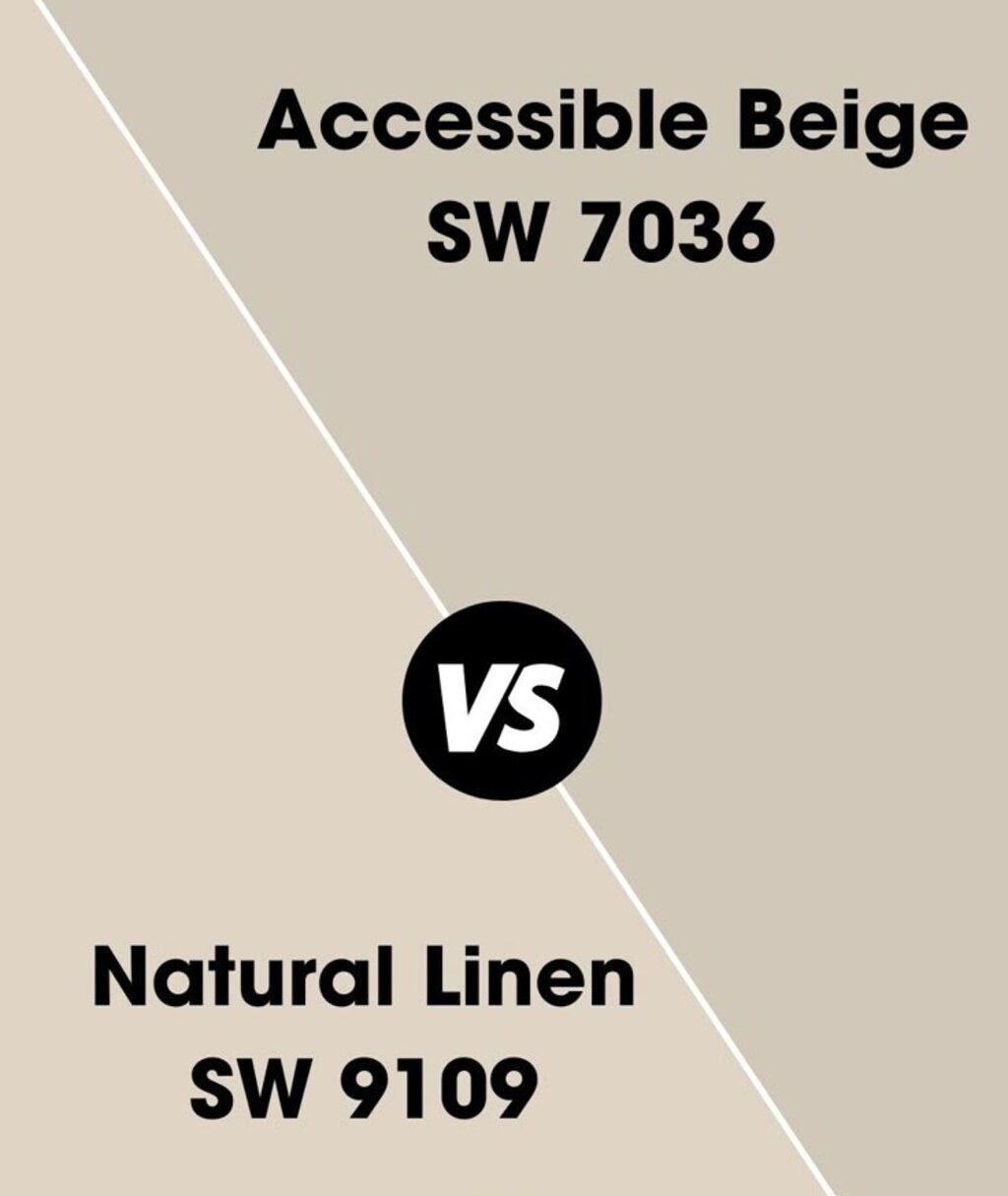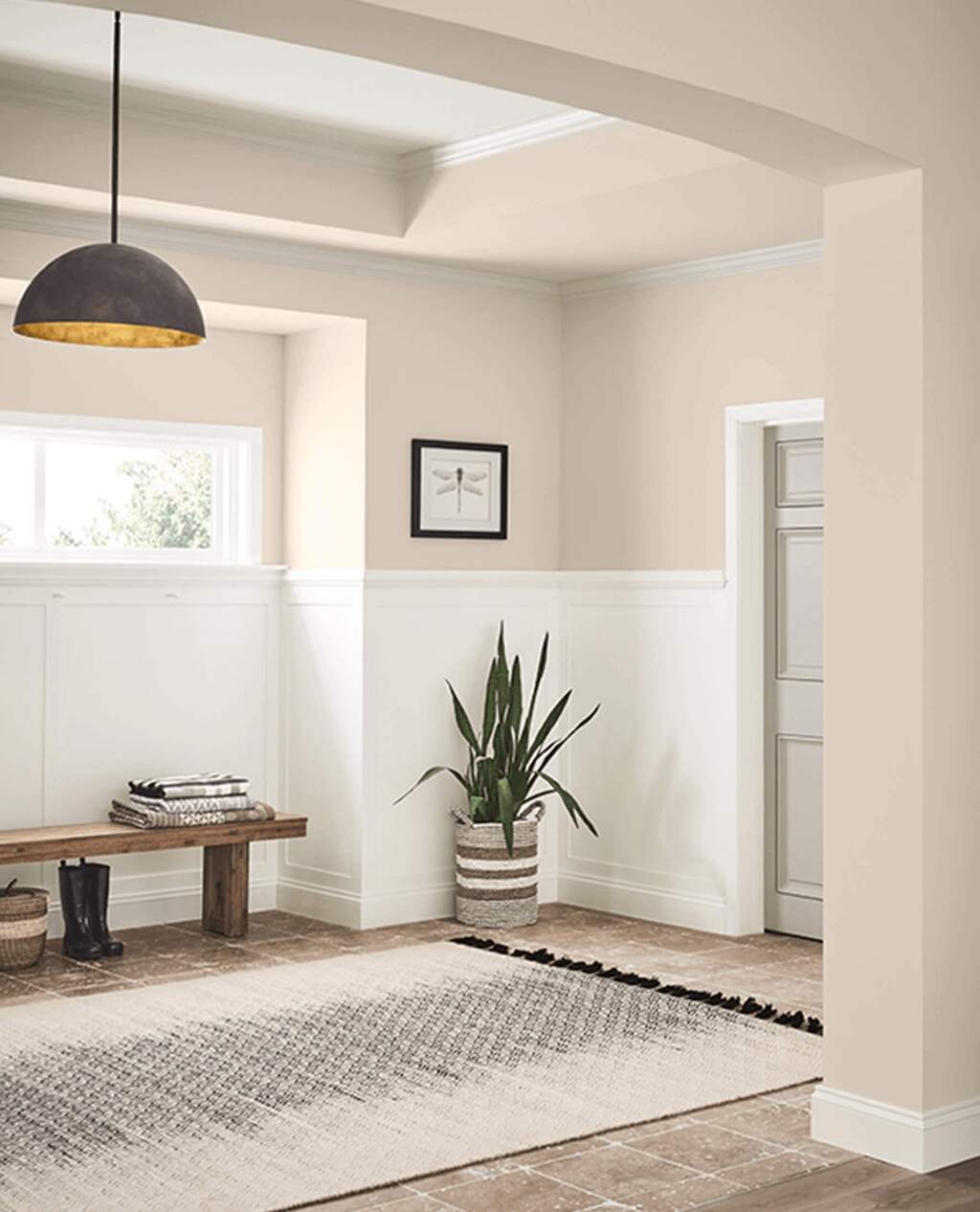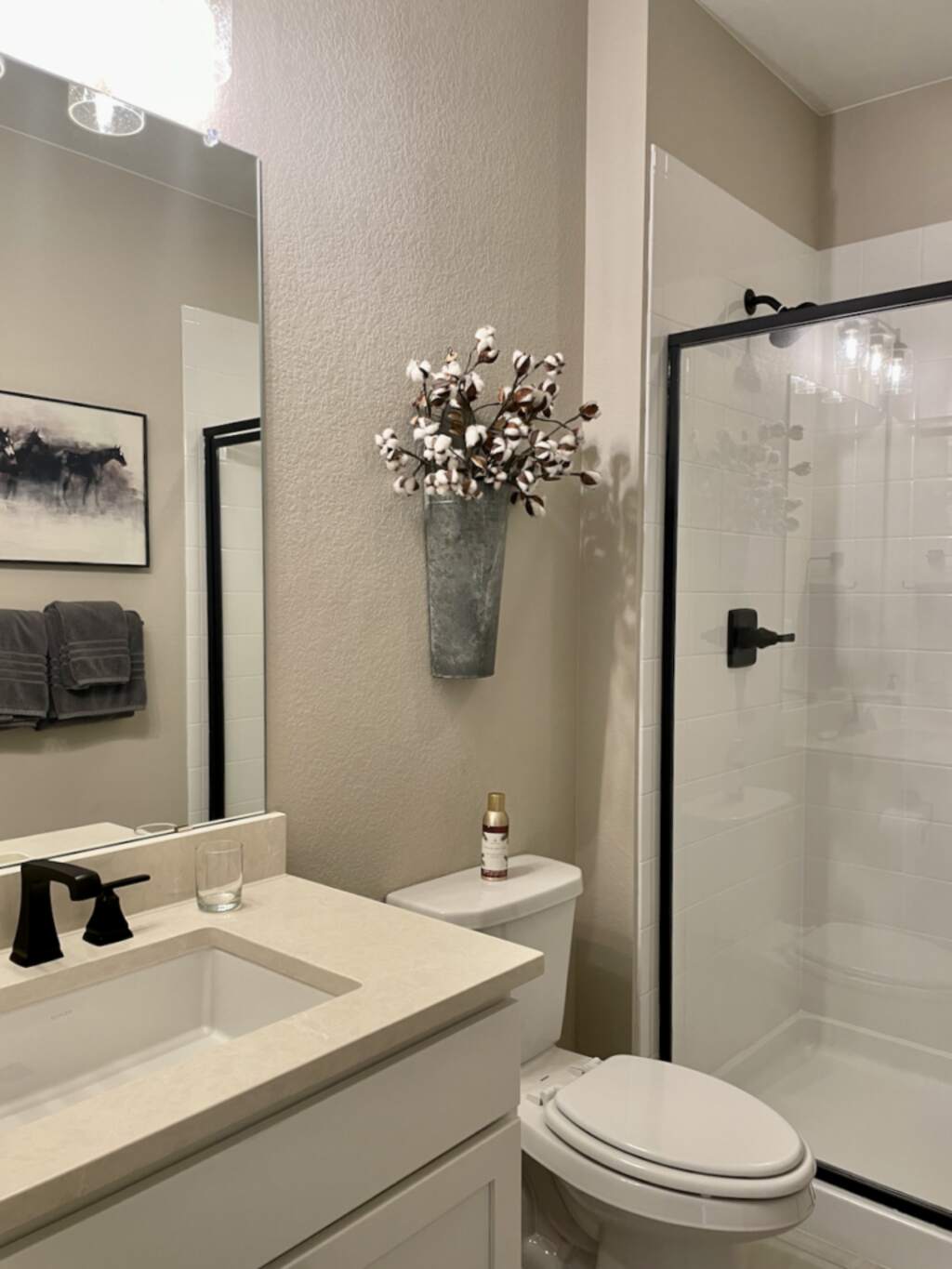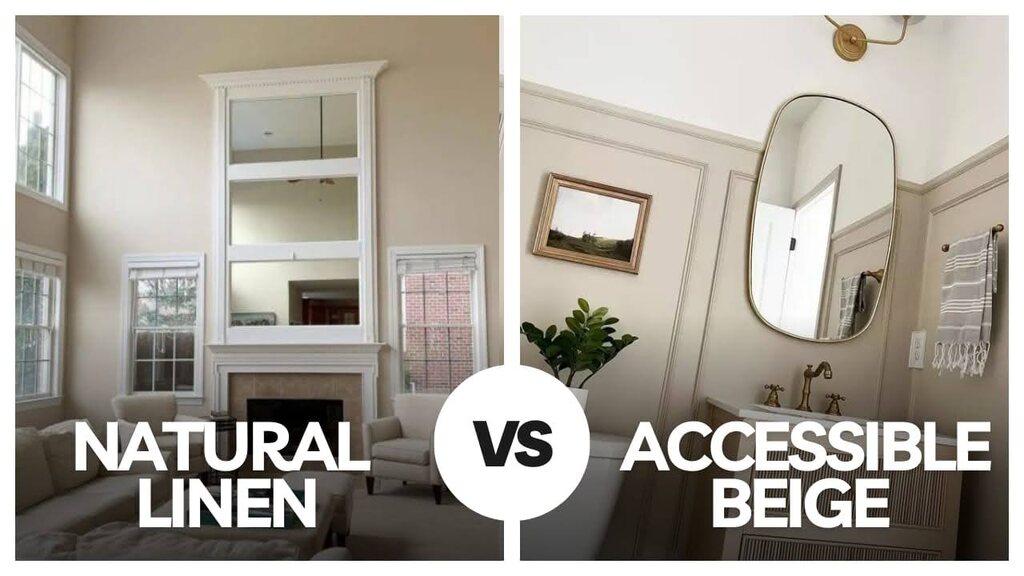In this blog, I’ll dive deep into the nuances of two popular hues to help you make a confident choice that will elevate your home, Natural Linen vs Accessible Beige.
When it comes to choosing the perfect neutral for your home, the options can feel overwhelming. Two colors that frequently confuse are Sherwin-Williams Natural Linen and Accessible Beige. So, which one should you pick for your space? Will Natural Linen blend seamlessly with your decor, or does Accessible Beige have that perfect undertone you’re searching for?
Keep reading to discover which color will truly work best in your home.
Natural Linen (SW 9109)
Natural Linen is a soft, light beige with a touch of warmth, making it feel cozy and inviting. It has a slightly creamy undertone, which gives it a subtle richness without overwhelming a room.
This color works beautifully in spaces that need warmth and light, such as living rooms, bedrooms, or even kitchens.
Its calm and neutral character pairs well with both contemporary and traditional styles.
With an LRV (Light Reflectance Value) of 69, it’s considered a medium-light color that can brighten up a room while maintaining a sense of grounded warmth.
Accessible Beige (SW 7036)

Accessible Beige is another warm, soft beige but with a more neutral balance of undertones, giving it a more versatile and adaptable feel.
It leans slightly more toward gray than Natural Linen, giving it a sophisticated, understated look.
With an LRV of 58, it’s a bit deeper, creating a cozy yet open atmosphere that works well in a variety of spaces—from living rooms to hallways or even bathrooms.
This color complements both warm and cool tones, making it ideal for creating a balanced palette in any home.
Comparing LRVs
With an LRV of 69, Natural Linen is a medium-light shade, reflecting a fair amount of light while still maintaining warmth and depth.
In rooms with south-facing windows, this color will look lighter and brighter because it will be exposed to more natural sunlight throughout the day.
The warmth in Natural Linen will be enhanced by the abundance of sunlight, creating an inviting and airy atmosphere.
Accessible Beige has an LRV of 58, which is a bit deeper and less reflective than Natural Linen.
In north-facing rooms, the lower amount of natural light will cause Accessible Beige to take on a more neutral, somewhat muted tone.
Its cool undertones will be less pronounced in this type of light, and the color may appear a little darker and cozier, making it perfect for creating a calming, grounded atmosphere.
Comparing RGB and Undertone
Natural Linen (SW 9109) has warm, creamy undertones with an RGB value of 217, 206, and 186, giving it a soft, golden beige hue.
The higher red and green values in its RGB makeup lend it a cozy, inviting feel, making it perfect for spaces that need warmth and light.
The yellow undertones enhance its welcoming nature, allowing it to work well with earthy tones or rich wood accents, creating a natural, relaxed atmosphere.
On the other hand, Accessible Beige (SW 7036) leans toward a more neutral base with an RGB value of 185, 169, 141.
Its subtle gray-beige undertones give it a more muted, sophisticated look, with enough warmth to keep it from feeling cold.
This color’s balanced neutrality makes it versatile, pairing effortlessly with cool tones like blues and greens, as well as modern or minimalist décor, for a chic, refined look.
Comparing VOC
When comparing the Volatile Organic Compound (VOC) levels of Natural Linen (SW 9109) and Accessible Beige (SW 7036), it’s important to consider their environmental impact and how they affect indoor air quality.
Both of these colors are part of Sherwin-Williams’ “Low VOC” category, which means they are designed to release fewer harmful chemicals into the air compared to traditional paints.
This makes them a safer option for your home, particularly in rooms with limited ventilation.
While both Natural Linen and Accessible Beige have relatively low VOC content, it;s always good to check the specific VOC levels for the exact product type (e.g., paint, primer) as it can vary slightly.
Here’s a quick comparison table for Natural Linen (SW 9109) and Accessible Beige (SW 7036):
|
Feature |
Natural Linen (SW 9109) |
Accessible Beige (SW 7036) |
|
RGB Values |
217, 206, 186 |
185, 169, 141 |
|
LRV |
69 |
58 |
|
Undertones |
Warm, golden, creamy |
Neutral, gray-beige |
|
VOC Levels |
Low VOC |
Low VOC |
|
Ideal Room Type |
Living rooms, bedrooms, kitchens |
Living rooms, hallways, bathrooms |
|
Best For |
Cozy, inviting, warm environments |
Sophisticated, neutral, versatile spaces |
Where to use Natural Linen?

I’ve had the pleasure of using Natural Linen (SW 9109) in my own home, and let me tell you, it;s been a game-changer!
I decided to try it out in my living room, and it instantly transformed the space into a cozy, inviting haven.
The warm, golden undertones worked beautifully with my wooden furniture and gave the room a soft, sun-kissed glow, even on the cloudiest days.
I also used it in the bedroom, where it helped create a calm, peaceful vibe—perfect for winding down after a busy day.
Whether it’s for your living room, bedroom, or even the kitchen, this color works wonders in spaces that need a little extra coziness without being too overpowering.
If you’re after a soft, welcoming atmosphere that feels natural and timeless, I highly recommend giving Natural Linen a try—it might just be the perfect neutral for your home too.
Where to use Accessible Beige?

I’ve also had the chance to experiment with Accessible Beige (SW 7036), and I can honestly say it;s one of those colors that seamlessly fits into just about any room.
I used it in my hallway, and it helped open up the space while still feeling warm and grounded.
It’s also been a perfect choice for my bathroom, where I wanted something calm and versatile but still had a touch of warmth.
If you’re wondering where to use Accessible Beige in your own home, I;d suggest trying it in spaces like hallways, bathrooms, or even as an accent in your home office.
I think you’ll find that Accessible Beige adds a calming and sophisticated touch to any room it graces.
Conclusion
In conclusion, both Natural Linen (SW 9109) and Accessible Beige (SW 7036) bring unique qualities to your home, each offering a different vibe while maintaining warmth and versatility. Ultimately, the best choice depends on the mood you want to create and the specific needs of your space.
Whether you’re drawn to the inviting warmth of Natural Linen or the chic, balanced neutrality of Accessible Beige, both colors offer timeless elegance that will elevate any room. The key is to consider how each color interacts with your room’s light, décor, and purpose to create the ideal atmosphere for your home.
FAQs
Can I use Natural Linen and Accessible Beige together in the same room?
Absolutely! These two colors can complement each other beautifully. You could use Natural Linen as a wall color for a light, warm foundation while using Accessible Beige for trim, accent walls, or furniture to create a balanced, sophisticated look. They work well together because of their similar undertones and warm appeal.
How do Natural Linen and Accessible Beige compare in terms of maintenance?
Both colors are low-maintenance, especially if you use them in areas with low traffic. Their warm, neutral tones help conceal minor dirt and imperfections. Regular cleaning with a soft cloth or mild soap solution will keep them looking fresh.
Does the lighting in a room affect how Natural Linen or Accessible Beige looks?
Yes! Lighting plays a crucial role in how both colors appear. Natural Linen may look lighter and warmer in rooms with ample sunlight, especially those facing south. In contrast, Accessible Beige may appear darker and deeper in north-facing rooms with less natural light, enhancing its cozy, grounded feel.
How do I choose between Natural Linen and Accessible Beige for my home?
Think about the ambiance you want to create. If you’re looking for a light, airy feel with warmth, Natural Linen is your go-to. If you prefer something more neutral, sophisticated, and adaptable, Accessible Beige will suit your space perfectly. Consider the direction your room faces and the amount of natural light it receives for the best results.

